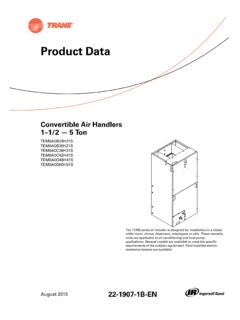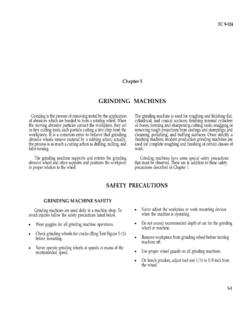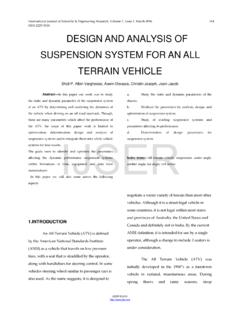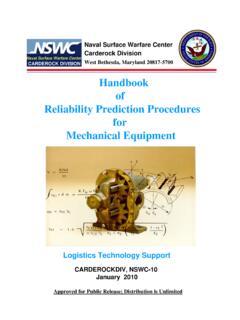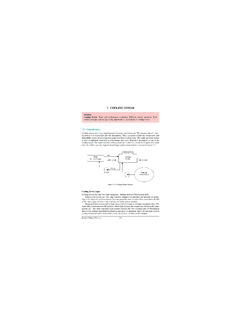Transcription of Chapter 18: Variable Frequency Drive Evaluation Protocol
1 Chapter 18: Variable Frequency Drive Evaluation Protocol The Uniform Methods Project: Methods for Determining Energy Efficiency Savings for Specific Measures Created as part of subcontract with period of performance September 2011 December 2014. Jeff Romberger SBW Consulting, Inc. Bellevue, Washington NREL Technical Monitor: Charles Kurnik NREL is a national laboratory of the Department of Energy Office of Energy Efficiency & Renewable Energy Operated by the Alliance for Sustainable Energy, LLC. This report is available at no cost from the National Renewable Energy Laboratory (NREL) at Subcontract Report NREL/SR-7A40-63166. November 2014. Contract No. DE-AC36-08GO28308. Chapter 18: Variable Frequency Drive Evaluation Protocol The Uniform Methods Project: Methods for Determining Energy Efficiency Savings for Specific Measures Created as part of subcontract with period of performance September 2011 December 2014.
2 Jeff Romberger SBW Consulting, Inc. Bellevue, Washington NREL Technical Monitor: Charles Kurnik Prepared under Subcontract No. LGJ-1-11965-01. NREL is a national laboratory of the Department of Energy Office of Energy Efficiency & Renewable Energy Operated by the Alliance for Sustainable Energy, LLC. This report is available at no cost from the National Renewable Energy Laboratory (NREL) at National Renewable Energy Laboratory Subcontract Report 15013 Denver West Parkway NREL/SR-7A40-63166. Golden, CO 80401 November 2014. 303-275-3000 Contract No. DE-AC36-08GO28308. NOTICE. This report was prepared as an account of work sponsored by an agency of the United States government. Neither the United States government nor any agency thereof, nor any of their employees, makes any warranty, express or implied, or assumes any legal liability or responsibility for the accuracy, completeness, or usefulness of any information, apparatus, product, or process disclosed, or represents that its use would not infringe privately owned rights.
3 Reference herein to any specific commercial product, process, or service by trade name, trademark, manufacturer, or otherwise does not necessarily constitute or imply its endorsement, recommendation, or favoring by the United States government or any agency thereof. The views and opinions of authors expressed herein do not necessarily state or reflect those of the United States government or any agency thereof. This report is available at no cost from the National Renewable Energy Laboratory (NREL) at Available electronically at Available for a processing fee to Department of Energy and its contractors, in paper, from: Department of Energy Office of Scientific and Technical Information Box 62. Oak Ridge, TN 37831-0062. phone: fax: email: Available for sale to the public, in paper, from: Department of Commerce National Technical Information Service 5285 Port Royal Road Springfield, VA 22161.
4 Phone: fax: email: online ordering: Cover Photos: (left to right) photo by Pat Corkery, NREL 16416, photo from SunEdison, NREL 17423, photo by Pat Corkery, NREL. 16560, photo by Dennis Schroeder, NREL 17613, photo by Dean Armstrong, NREL 17436, photo by Pat Corkery, NREL 17721. NREL prints on paper that contains recycled content. Acknowledgments The Chapter author wishes to thank and acknowledge Mike Rufo of Itron, and David Jacobson of Jacobson Energy Research LLC for their thoughtful contributions. iii This report is available at no cost from the National Renewable Energy Laboratory (NREL) at Acronyms ASD Adjustable-speed Drive BAS Building automation system CV Constant volume DOE Department of Energy HVAC Heating, ventilation, and air conditioning IPMVP International Performance Measurement and Verification Protocol M&V Measurement and verification OAT Outside air temperature RMS Root mean square RTF Regional Technical Forum TMY Typical Meteorological Year VAV Variable air volume VFD Variable Frequency Drive VSD Variable -speed Drive iv This report is available at no cost from the National Renewable Energy Laboratory (NREL) at Table of Contents 1 Measure Description.
5 1. 2 Application Conditions of Protocol .. 2. 3 Savings Calculations .. 4. 4 Measurement and Verification Plan .. 5. Performance Curve Method .. 5. Eligible Projects .. 6. Data Collection Requirements .. 6. Savings Estimation Steps .. 8. Default Curve Method .. 11. Eligible Projects .. 11. Data Collection Requirements .. 13. Savings Estimation Steps .. 15. Regression Modeling Direction .. 17. Testing Model Validity .. 17. 5 Sample Design .. 19. 6 Other Evaluation Issues .. 20. Net-to-Gross Estimation .. 20. Realization Rates .. 20. References .. 21. Resources .. 22. v This report is available at no cost from the National Renewable Energy Laboratory (NREL) at List of Tables Table 1. Fan Default Curve Correlation Coefficients .. 12. Table 2. Pump Default Curve Correlation Coefficients .. 12. Table 3. Model Statistical Validity Guide.
6 18. vi This report is available at no cost from the National Renewable Energy Laboratory (NREL) at 1 Measure Description An adjustable-speed Drive (ASD) includes all devices that vary the speed of a rotating load, including those that vary the motor speed and linkage devices that allow constant motor speed while varying the load speed. The Variable Frequency Drive Evaluation Protocol presented here addresses Evaluation issues for Variable - Frequency drives (VFDs) installed on commercial and industrial motor-driven centrifugal fans and pumps for which torque varies with speed. 1 Constant torque load applications, such as those for positive displacement pumps, are not covered by this Protocol . Other ASD devices, such as magnetic Drive , eddy current drives, Variable belt sheave drives, or direct current motor Variable voltage drives, are also not addressed.
7 The VFD is by far the most common type of ASD hardware. With VFD speed control on a centrifugal fan or pump motor, energy use follows the affinity laws, which state that the motor electricity demand is a cubic relationship to speed under ideal conditions. Therefore, if the motor runs at 75% speed, the motor demand will ideally be reduced to 42% of full load power; however, with other losses it is about 49% of full load power. VFDs are commonly used on other motor-driven equipment such as air compressors, refrigeration compressors, vacuum pumps, and high-pressure blowers. These devices are typically positive displacement machines and are not included under this Protocol , but in some cases will be addressed in protocols that are specific to them. This Protocol is also not intended to address conditions where there is significant interaction with other end uses, such as heating or cooling.
8 For example, VFDs on refrigeration evaporator fans are not addressed because the fans significantly impact refrigeration load. VFDs on cooling tower fans are not addressed because the fans are often combined with condenser water temperature control, which impacts the chiller energy use. Conversion of constant volume (CV). heating, ventilation, and air conditioning (HVAC) systems to Variable air volume (VAV) systems can have significant impacts on heating and cooling loads. In some cases no interaction may occur, such as CV-to-VAV conversion of parking garage ventilation fans. These may be applicable to this Protocol because no interaction with other end uses takes place. Other cases may be considered if the interaction is expected to be small compared to the fan motor energy savings. 1. As discussed in Considering Resource Constraints in the Introduction of this report, small utilities (as defined under the Small Business Administration regulations) may face additional constraints in undertaking this Protocol .
9 Therefore, alternative methodologies should be considered for such utilities. 1. This report is available at no cost from the National Renewable Energy Laboratory (NREL) at 2 Application Conditions of Protocol Market transformation is occurring for VFDs on HVAC fans and pumps for new construction. Building codes vary by jurisdiction, but some require VFDs on all HVAC fans and pumps for a certain size, such as the California Title 24 building code, which requires VFDs on all HVAC. fans and pumps greater than 10 horsepower. Some jurisdictions continue to use building codes that do not yet address VFDs as a requirement. In general, building codes do not address VFD requirements for industrial process fans and pumps. Retrofit of existing HVAC pumps and fans with VFDs remains a common application. Generally, VFDs for HVAC applications tend not to save electricity during system peak hours, because that is often the time of peak HVAC fan and pump demand.
10 The VFD electricity demand will be greater during peak use (if the Drive is operating at full speed or faster during peak periods), because the VFD is typically about 97% efficient at full speed. Given that this depends on the peak savings definition and defined peak period, some jurisdictions may have peak savings. To determine if peak savings may occur, care should be taken to understand the load profile during the peak period of the motor on which VFD is installed. There are some specific cases where savings do occur during peak periods, such as a chilled water pump that has a throttling valve that is opened fully after the VFD is installed, which allows the VFD to operate at less than full speed even at peak flow. Energy efficiency programs encourage the use of VFDs (as retrofits and in new construction) on fans and pumps that serve loads that vary over time, even if the local energy code does not require them.











